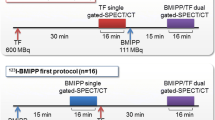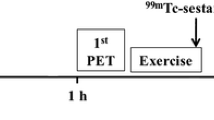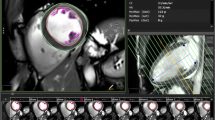Abstract.
A dual-isotope simultaneous acquisition (DISA) single-photon emission tomography (SPET) protocol with fluorine-18 fluorodeoxyglucose (18F-FDG) and a technetium-99m labelled flow tracer is attractive because it permits assessment of both myocardial glucose utilisation and flow within a single study. Differences in physical and physiological characteristics between 18F-FDG and the 99mTc-labelled flow tracer, however, may cause differences in myocardial activity distribution between the agents. The aim of this study was to investigate the relation between the myocardial distribution of 18F-FDG and a 99mTc-labelled flow tracer on DISA SPET in comparison with nitrogen-13 ammonia/18F-FDG positron emission tomography (PET). Nine normal volunteers without cardiac disease and ten patients with known coronary artery disease (CAD) underwent 13N-ammonia/18F-FDG PET and 99mTc-sestamibi/18F-FDG DISA SPET. Using a semiquantitative polar map approach, the left ventricular myocardium was divided into nine segments, and relative regional activity was calculated for each segment. A segment was considered to have concordant uptake between 18F-FDG and flow tracer if the difference in measured regional activity between the tracers was ≤10% of peak activity, and the percentage of concordant segments was calculated for each subject. There was a good overall concordance of myocardial activity between the agents on DISA SPET (84.0%±14.8%) in normals, which was comparable to that seen on PET (86.4%±14.5%, NS vs DISA SPET). However, the myocardial activity distributions of 18F-FDG and flow tracer were not identical in that reduced flow tracer activity was seen in the basal segments on DISA SPET in both normals and CAD patients. It is concluded that there is good overall concordance of activity between 18F-FDG and flow tracer in normal myocardium on DISA SPET, which is comparable to that on PET, supporting the use of combined 99mTc-flow tracer/18F-FDG imaging for the detection of viable myocardium. However, there is a difference in the myocardial activity distribution between the agents in both normals and CAD patients, the difference being particularly evident in the basal segments. Therefore, careful image interpretation that takes into consideration the different normal activity distribution between the tracers and/or a tracer-specific normal database is necessary for comparison with patient studies.
Similar content being viewed by others
Author information
Authors and Affiliations
Additional information
Received 24 February and in revised form 9 May 2002
Electronic Publication
Rights and permissions
About this article
Cite this article
Matsunari, I., Kanayama, S., Yoneyama, T. et al. Myocardial distribution of 18F-FDG and 99mTc-sestamibi on dual-isotope simultaneous acquisition SPET compared with PET. Eur J Nucl Med 29, 1357–1364 (2002). https://doi.org/10.1007/s00259-002-0889-z
Published:
Issue Date:
DOI: https://doi.org/10.1007/s00259-002-0889-z




